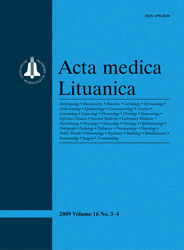
ISSN 1392-0138
ISSN 2029-4174 (online)
|
2009 m. Nr. 3-4
 Male breast cancer: temporal trends and treatment in
Lithuania
Algirdas JACKEVIČIUS, Leonarda ŠARAKAUSKIENĖ, Valerijus OSTAPENKO, Juozas KURTINAITIS,
Saulius BRUŽAS, Algimantas MUDĖNAS
Male breast cancer is a rare disease in Lithuania, comprising less than 0.2% of malignancies
among men. During the last decade, there has been no change in the frequency of
the disease, with 10–15 cases registered every year during 1988–2006, and only 16 of the
more than 8000 new cases in 2006 presented male breast carcinoma. Data published in the
Cancer Incidence in Five Continents during 1978–2002 show no changes in the variability
of the rate of incidence of male breast carcinoma either.
Materials and methods. This investigation analyzed 100 male patients with breast carcinoma
treated during the period 1988–2006 in two clinics: Institute of Oncology at Vilnius
University and Hospital of Oncology at Kaunas University of Medicine. The average age
of the patients was 67.5 years (range, 31–90 years). The patients were grouped according
to the progression of the disease: 13 patients in stage I, 41 patients in stage II, 31 patients
in stage III, and 15 patients in stage IV. The type of cancer was as follows: invasive ductal
carcinoma was the most frequent (68 cases), lobular carcinoma in 9 cases, and adenocarcinoma
in 6 cases. The most common method of treatment was modified mastectomy by
Madden (75 cases). Furthermore, 53 patients received a combined treatment: 23 patients
were treated with radiotherapy, 9 patients with chemotherapy, 14 patients received radiotherapy
and chemotherapy, and 14 patients were treated with tamoxifen.
Results. The status of the patients was validated up to December 31, 2007 by checking
the active follow-up examinations as well as utilizing the assistance and results of primary
health care centers and the population registry. The overall survival rates were calculated
using mortality issues as primary endpoints. The overall 5-year survival rate of all male patients
with breast carcinoma was estimated to be 42.7%. The 5-year survival rate of the patients
in stages I and IIA was 71.9% and 79.5%, respectively, and in stage IIB 53.5%. Lower
survival rates (15.8% and 11.2%) were observed in stage IIIA and stage IIIB, respectively.
None of the patients in stage IV survived beyond 5 years. A 2-year survival rate of 6.7% was
the best estimate of this group.
Conclusion. The overall survival rate of male breast cancer patients treated at two major
medical centers of Lithuania was estimated to be below 50%. Thes low survival rate can
be explained by late detection of advanced cases and the lack of innovation during cancer
treatment.
Keywords: male breast cancer, treatment, survival
|
Issues:
2011 - Vol.18 No. 1, No. 2, No. 3, No. 42010 - Vol.17 No. 1-2, No. 3-42009 - Vol.16 No. 1-2, No. 3-42008 - Vol.15 No. 1, No. 2, No. 3, No. 42007 - Vol.14 No. 1, No. 2, No. 3, No. 42006 - Vol.13 No. 1, No. 2, No. 3, No. 42005 - Vol.12 No. 1, No. 2, No. 3, No. 42004 - Vol.11 No. 1, No. 2, No. 3, No. 42003 - Vol.10 No. 1, No. 2, No. 3, No. 42002 - Vol.9 No. 1, No. 2, No. 3, No. 42001 - Vol.8 No. 1, No. 2, No. 3, No. 4 |
